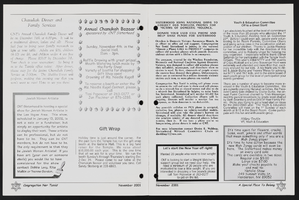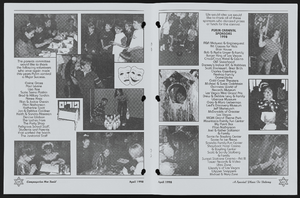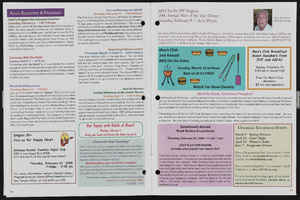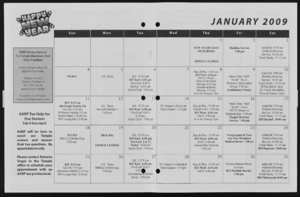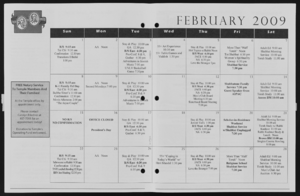Search the Special Collections and Archives Portal
Search Results

Interview with Harold Melvin Agnew, October 10, 2005
Date
2005-10-10
Archival Collection
Description
Narrator affiliation: Physicist; Director, Los Alamos National Laboratory
Text

Meeting minutes for Consolidated Student Senate, University of Nevada, Las Vegas, April 26, 2004
Date
2004-04-26
Archival Collection
Description
Includes meeting minutes and agenda, along with additional information about Rebel Yell Operating Policy, Articles of Incorporation, and the Leadership of Advisory Board.
Text

Transcript of interview with Mindy Unger-Wadkins by Barbara Tabach, October 28, 2015
Date
2015-10-28
Archival Collection
Description
In this interview, Unger-Wadkins discusses growing up in Las Vegas? close-knit Jewish community in the 1960s and 1970s, and involvement with various Jewish youth organizations and activities. She also describes her career in public relations, reflecting upon the unique challenges faced when interacting with the public, and with politics, in her positions. Unger-Wadkins ends by describing her current work in land development, particularly the history of the Three Kids Mine and the technical and political process of ensuring the land is suitable as a residential area.
Text
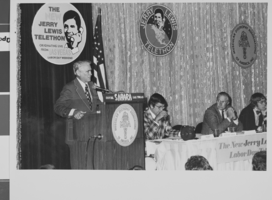
Photograph of Mayor Oran K, Gragson speaking at the pre-telethon production meeting, Las Vegas, Nevada, 1974
Date
1974
Archival Collection
Description
Las Vegas Mayor Oran K. Gragson (at the podium) addressing the general session at the pre-telethon production meeting for the Jerry Lewis Muscular Dystrophy Telethon at the Sahara Hotel and Casino. Oran Kenneth Gragson (February 14, 1911 – October 7, 2002) was an American businessman and politician. He was the longest-serving mayor of Las Vegas, Nevada, from 1959 to 1975. Gragson, a member of the Republican Party, was a small business owner who was elected Mayor on a reform platform against police corruption and for equal opportunity for people of all socio-economic and racial categories. Gragson died in a Las Vegas hospice on October 7, 2002, at the age of 91. The Oran K. Gragson Elementary School located at 555 N. Honolulu Street, Las Vegas, NV 89110 was named in his honor. The Jerry Lewis MDA Labor Day Telethon was an annual telethon held each Labor Day in the United States to raise money for the Muscular Dystrophy Association (MDA). The show was founded and hosted by actor and comedian Jerry Lewis, who hosted the broadcast from its 1966 inception until 2010. The history of MDA's telethon dated back to the 1950s, when the Jerry Lewis Thanksgiving Party for MDA raised funds for the organization's New York City area operations. The telethon was held annually on Labor Day weekend beginning in 1966, and would raise $2.45 billion for MDA from its inception through 2009. The telethon aired up to 21½ hours, starting on the Sunday evening preceding Labor Day and continuing until late Monday afternoon on the holiday itself. MDA called its network of participating stations the "Love Network". The show originated from Las Vegas for 28 of the years it was broadcast. Beginning in 2011, coinciding with Lewis's controversial departure, MDA radically reformatted and shortened the telethon's format into that of a benefit concert, shortening the length of the special each successive year. Successive telethons from 2012 to 2014 renamed the show as the MDA Show of Strength and further cut its airtime. The 2012 edition was reduced to three hours as a primetime-only broadcast. The 2012 edition did not refer itself as a "telethon". The 2013 Show of Strength discontinued the long-standing format of being syndicated to individual stations of varying network affiliation and aired on a major national network instead of being syndicated to individual stations, airing on ABC on Sunday, September 1, 2013, and being reduced to two hours. While the 2012 edition did not refer itself as a "telethon", it referred itself as such for the 2013 edition. The final edition, for 2014, aired on ABC on August 31, again as a two-hour special beginning at 9PM ET/PT. This was the final edition for the telethon, as it was announced on May 1, 2015 that the MDA would be discontinuing the annual event.
Image
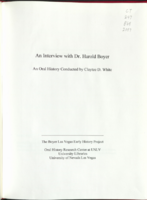
Transcript of interview with Dr. Harold Boyer by Claytee D. White, November 15, 2000
Date
2000-11-15
Archival Collection
Description
Dr. Harold Boyer recalled with great clarity his childhood in Arkansas. Born in 1916 in Hartman, he attended a two-story school which went to eighth grade, fished in a nearby stream, and earned money from the age of six selling newspapers. He remembered that his father wore many hats, including that of town physician, president of the school board, and mayor. He also operated the movie theater and would drive around town announcing upcoming film features through a megaphone. Harold gave details of living through the Great Depression and completing his high school and college education. Dr. Boyer recited many details of his life in the Marine Corps as a medic, serving on active duty in the Pacific arena in WWII, going into medical practice in Oklahoma City and Enid, Oklahoma, and being called back to serve in Korea. In 1952, while checking out practices in several Southwest locations, he came to Las Vegas and interviewed with Dr. Carver Coffman. Harold painted a picture of Las Vegas in the sixties and described his practice and the many organizations in which he participated. He described how certain entities contributed significantly to the growth in the Vegas Valley, including the Convention Bureau, the Elks Club, Rotary Club, Shriners, the Mormon Church, the Mesquite Club, the university, and the gaming industry. He also gave a very positive view of the cultural activities that were/are available to the people of Las Vegas. Comments by Dr. Boyer on race relations recalled the sixties when integration in area schools, hotels, and neighborhoods became a reality under strong black leadership. He also talked about the relationship between casino operators and the civic organizations previously mentioned, and included an anecdote concerning one of his patients and A1 Capone. Helldorado, a unique community celebration, began in 1937 and was designed to draw positive attention to Las Vegas and pull people together. Dr. Boyer described the parades, dances, games, and barbecues that made it so much fun, and listed the founders who made it possible. This list includes people like the Von Tobels, Bob Squires, Bill Ferret, and the Ronzoni family. He related that Helldorado gradually faded out as corporations took over the gaming industry and the population grew to hundreds of thousands. Howard Hughes, the Greenbaums, and Bugsy Siegel are some of the people Dr. Boyer recalled as part of the fabulous tapestry that makes Las Vegas special. He talked about those who had a positive influence on the town, like Ed Von Tobel, Jess Abbott, and Jackie Gaughan. He has wonderful ideas for creating a park near the downtown area that would rival Central Park in New York, Golden Gate Park in San Francisco, or Audubon Park in New Orleans. His closing comments reflect on special projects conducted by the Rotary Club and the future of Las Vegas as an international air travel transportation hub.
Text
Pagination
Refine my results
Content Type
Creator or Contributor
Subject
Archival Collection
Digital Project
Resource Type
Year
Material Type
Place
Language
Records Classification

